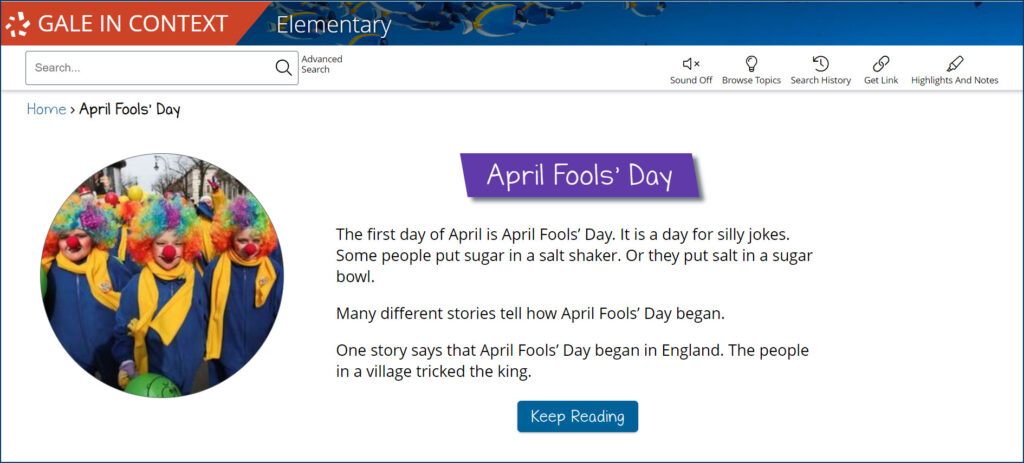| By Gale Staff |
Falling on April 1 each year, April Fools’ Day is a playful occasion for harmless pranks and hijinks. Elementary educators no doubt have a little something up their sleeves already, but why not build a themed lesson plan around the holiday as well? April Fools’ Day is celebrated worldwide, with different countries claiming their own origin stories and practicing unique traditions. All jokes aside, April Fools’ Day is a puzzling but fun topic for you and your young researchers to explore.
Boost your April Fools’ Day lesson plan with the helpful content in Gale In Context: Elementary. This curated database is a comprehensive resource designed especially for elementary learners. They’ll find thousands of easy-to-search collections packed with colorful images, thought-provoking prompts, and customization features for individualized learning.
This spring, integrate Elementary with your lesson planning and give your students the tools to grow as young learners. Get curious about April Fools’ Day and see what you can discover within the database.
Highlight Fun Facts and Famous Jokes
To get started, Gale In Context: Elementary hosts a special April Fools’ Day portal. This collection provides a one-stop shop for related magazine articles, reference tools, and news stories. Learn the basics of the holiday through our dedicated summary page, which outlines possible origin stories for the holiday as well as a few famous pranks.
Did you know that in 1996, Taco Bell hilariously told the public that, to assist in reducing the national debt, the fast-food chain had purchased the iconic Liberty Bell? To really sell the bit, the company even bought newspaper ads; the joke was so convincing that U.S. officials held a press conference to dispel the fake news.
Taco Bell was hardly the first to use the media to push its April Fools’ tricks. In 1957, the BBC convinced some viewers that spaghetti grew on trees. The network even aired a segment featuring a Swiss family harvesting long spaghetti noodles from trees. Apparently, the story was persuasive enough that a few people called the network to learn more about this home-grown pasta.
In modern times, companies use social media to instigate their April Fools’ Day pranks. On April 1, 2010, Google pretended to change its name to Topeka. In 2015, Cottonelle tweeted about its new ReverseRipple toilet paper, designed specifically for lefties. These stories will undoubtedly get a giggle from your classroom. Encourage students to find even more unbelievable pranks throughout history.
Research April Fools’ Day Around the World
April Fools’ Day fun is hardly isolated to one country. Some historians claim the mischievous holiday began in England. According to The Guardian, a 1698 document details an April Fools’ Day prank during which individuals were invited to the “Annual Ceremony of Washing The Lions” at the Tower of London. Today, the Brits continue to engage in playful pranks on April 1, though people consider it bad luck to continue past noon.
Conversely, the French believe that King Charles IX initiated the holiday. In the 16th century, the country switched from the Julian to the Gregorian calendar, moving the beginning of the year from the end of March to the beginning of January. People continued to celebrate the last week of March through April 1 despite the change. The French celebrate April Fools’ Day by sneakily sticking paper fish to one another’s backs. The prankster then runs away and shouts, “poisson d’avril” (April fish)—a reference to young fish that hatch in April, which are especially easy to catch, or fool.
April Fools’ Day festivities stretch the globe, with odd and hilarious pranks from Brazil to Scotland to Iran. With Gale In Context: Elementary, you can use the April Fools’ Day theme to inspire your students’ interest in other countries. Discuss the similarities we share, and appreciate the differences between cultures worldwide.
Scheme a Few Classroom Pranks
Get inspired to plan a few classroom pranks with this Guide to April Fools’ Day Fun. Or, concoct a completely unique joke of your own. Here are a few of our favorite ideas.
Include a “Scratch-and-Sniff” Question
Assign a simple, silly digital quiz, and include a fake question with a “scratch-and-sniff” multiple-choice option. See how many students lean in to smell the computer screen.
Facilitate a “Lava Drill”
Instruct students that it’s time to practice a lava drill should the floor ever turn to lava. Students must cross the classroom to the exit without touching the floor.
Teach About the Spaghetti Harvest
Teach the BBC’s spaghetti tree prank as if it were an actual lesson. Start by showing students the original video and discuss different aspects like the “spaghetti weevil’s” impact on the spaghetti harvest and spaghetti tree growers’ dedication to breeding equal spaghetti lengths. Who recognizes it’s a prank first?
Assign a Fake Word Search
Hand out a word search with April Fools’ Day–themed words to find, such as prank, trickster, or mischief. However, don’t include any actual words within the word search. See how long it takes for students to catch on.
Bake Brown E’s
This joke is an oldie, but a goodie. Bring a tray of brownies to share with students (check for allergies first). Hide the tray and prepare a different plate filled with brown letter E’s instead. It’s easiest to simply use brown construction paper. Tell your students you made them a special treat . . . brown E’s! Pass out napkins and then enthusiastically place a brown letter E on each napkin. After a good chuckle, you can pass out the actual treats.
Add some silliness to your classroom planning as the spring season begins and the weather gets warmer. Gale In Context: Elementary can help you develop creative lessons that engage your students and make them laugh. April Fools’ Day presents an excellent opportunity to “trick” your students into learning; it combines a light-hearted topic with concrete practice for young research skills.
If your school is not a Gale subscriber, contact your local representative to learn more about our products.


